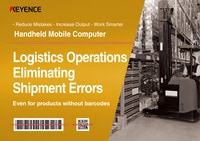Picking
The term picking is mainly used in logistics work and refers to the collecting and shipping of products stored in warehouses and distribution centres. In recent years, the load on picking has greatly increased due to the increased demand for online shopping. Handheld mobile computers have been installed in the logistics industry from early on. This section discusses picking work as a typical application, introducing items such as basic knowledge pertaining to picking, the flow for installing handheld mobile computers, the way to use handheld mobile computers, and the advantages of doing so.
- What Is Picking?
- Picking Methods and Problems
- Operation With Handheld Mobile Computers
- Advantages Provided by Handheld Mobile Computers
What Is Picking?
Picking refers to the work performed to take products from their storage locations and collect them in the shipping location. This term is used on a daily basis in the logistics industry. The product numbers and quantities are checked on the basis of the details written on the shipping instructions (the picking list), and the specified products are collected. Picking methods are mainly separated into two types: single picking and total picking.
Single picking
In single picking, products are collected and shipped for each shipping destination. This is also called order picking, and it is used to send a wide variety of products to many shipping destinations such as in online shopping. The advantages are that picking can be handled flexibly for each shipping destination and shipments can be sent immediately after packing.
Total picking
All the products are picked first and are then separated at the sorting location according to shipping destination. The total picking method is also called the assort method. This method is used when there are few shipping destinations and a large number of products are shipped to the same destination. The advantage is that all products are picked at the same time, which can reduce the travel distance of, time spent by, and hassle on workers.
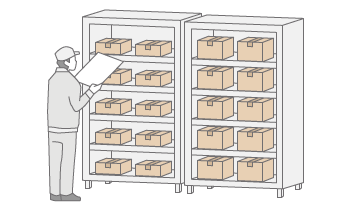
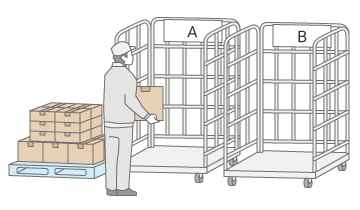
Picking Methods and Problems
Whether single picking or total picking is performed, the work involves workers finding products on the shelves in a warehouse or distribution centre, so the work highly depends on the people performing it. Hence, the problem exists that it is easy for variations between workers to occur in the speed and accuracy of picking. Furthermore, workers may forget to pick products and may pick the wrong products, so it was always necessary to perform inspections prior to shipping, which was a hassle.
Operation With Handheld Mobile Computers
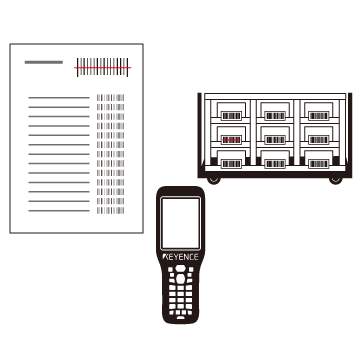
Picking conventionally relied on the memory of the people performing it, but as the number of products increases, so too does the hassle in searching for products, thereby increasing the possibility that workers will forget to pick products or will pick the wrong ones. It was also necessary to perform barcode inspections prior to shipping. However, these problems with picking can be solved by installing handheld mobile computers.
If items and locations (shelves, rows, and levels) are registered in advance and barcodes are written on the shipping instructions (the picking list), the worker only has to read a barcode with a handheld mobile computer to learn the information and accurate position of an item. Also, items can be inspected at the same time that they are picked by reading the barcodes of the items, which is efficient. Furthermore, from the point of view of product management, warehousing management can be carried out thoroughly, which makes it possible to perform accurate inventory management.
Advantages Provided by Handheld Mobile Computers
Picking work can be made more efficient by using handheld mobile computers. This section introduces the advantages that can be obtained by installing handheld mobile computers in picking work.
Being able to confirm product locations provides efficiency
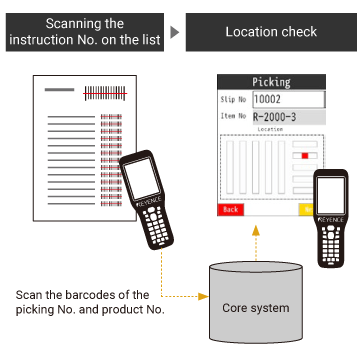
By reading a barcode written on the shipping instructions (the picking list), a worker can check the details and the accurate storage location of a product. This is efficient because it enables fast and accurate picking that does not rely on the worker's memory and experience. Workers can perform the same work regardless of experience, which shortens the time spent on personnel training and is also effective in reducing costs.
Picked products can be verified immediately
Pass/fail judgement can be performed on the spot by scanning product barcodes during picking and verifying this data against the picking list. Conventionally, it was necessary to perform a final check by reading barcodes prior to shipping, but installing handheld mobile computers makes it possible to perform inspections at the same time as picking.
Shipping labels can be issued for immediate shipping
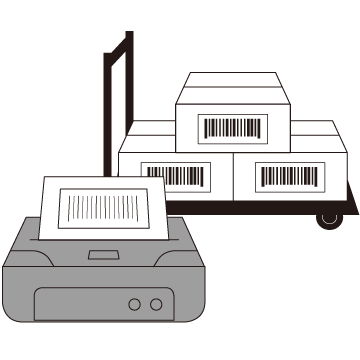
By connecting a printer to a handheld mobile computer, it can also issue shipping labels. Everything from picking to packing and the issuing and affixing of shipping labels can be performed smoothly, which makes the flow of picking, delivery, packing, and shipping efficient.


